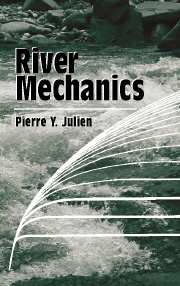Book contents
- Frontmatter
- Contents
- Preface
- Notation
- 1 Introduction to river mechanics
- 2 Physical properties and equations
- 3 River basins
- 4 Steady flow in rivers
- 5 Unsteady flow in rivers
- 6 River equilibrium
- 7 River dynamics
- 8 River stabilization
- 9 River engineering
- 10 Physical river models
- 11 Mathematical river models
- 12 Waves and tides in river estuaries
- Bibliography
- Index
1 - Introduction to river mechanics
Published online by Cambridge University Press: 05 June 2012
- Frontmatter
- Contents
- Preface
- Notation
- 1 Introduction to river mechanics
- 2 Physical properties and equations
- 3 River basins
- 4 Steady flow in rivers
- 5 Unsteady flow in rivers
- 6 River equilibrium
- 7 River dynamics
- 8 River stabilization
- 9 River engineering
- 10 Physical river models
- 11 Mathematical river models
- 12 Waves and tides in river estuaries
- Bibliography
- Index
Summary
It has long been understood that water flows downhill. This maybe the only statement to be remembered until a river dries out and crops wilt. Droughts unfortunately threaten humanity with the constraint that, without water, life cannot be sustained. On the other hand, the devastating consequences of excess water through floods stem from the fact that humanity, crops, and cattle are not well adapted to submerged life. Although nomadic tribes coped with the continuously changing pulses of fluvial systems, sedentary conditions forced humanity to protect against floods and droughts. In arid lands, perennial streams with regulated flowand a year-round supply of water are so much more valuable to humanity and wildlife than are natural sequences of short floods that succeed long droughts in dry ephemeral streams. River engineers are facing the daunting challenge of optimizing the urban and environmental resources pertaining to rivers while minimizing the damages caused by floods and droughts.
Perhaps the origin of river engineering started with Yu (4000 B.C.) who was selected to be emperor of China on the premise of long-lasting dikes for the protection of fertile Chinese plains against floods. For centuries, Chinese emperors were classified into “good dynasties” or “bad dynasties” depending on whether or not they succeeded in their struggle to harness large rivers. At approximately the same time, in Mesopotamia, an extensive irrigation system was developed between the Tigris and the Euphrates Rivers. Flood-control levees were constructed to protect fertile lands from destructive inundations.
- Type
- Chapter
- Information
- River Mechanics , pp. 1 - 8Publisher: Cambridge University PressPrint publication year: 2002
- 2
- Cited by



